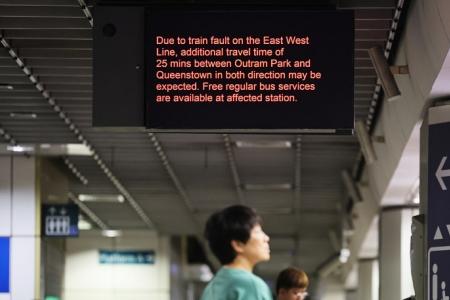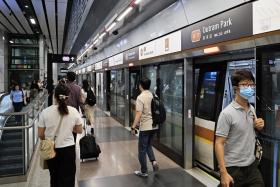SMRT forms group to look into reliability, safety issues
Public transport operator SMRT has formed a working group comprising representatives from the company, the Land Transport Authority (LTA) and the National Transport Workers’ Union (NTWU) to review the safety and reliability of its rail network.
The move comes in the wake of a recent spate of service disruptions that have afflicted rail lines run by SMRT, including one of the worst breakdowns to hit Singapore’s MRT system in its 37-year history, which crippled the East-West Line (EWL) for six days from Sept 25 to Sept 30.
In a Facebook post on Nov 1, SMRT said the new working group will have subject-matter experts from the operator and LTA. SMRT Trains president Lam Sheau Kai and LTA deputy chief executive for infrastructure and development Yee Boon Cheow will serve as the working group’s co-chairs.
Their task will be to evaluate existing systems and processes in areas such as life cycle management, asset renewal and maintenance practices.
As part of its review, the group will conduct a benchmarking exercise, comparing SMRT’s practices with those of the Guangzhou Metro Corporation, which operates the Guangzhou Metro, and the Taipei Rapid Transit Corporation, which operates the metro in the Taiwanese capital.
“This will allow us to exchange insights, and benchmark against the two leading metro operators with world-class safety and reliability records,” SMRT added.
Where applicable, lessons gleaned from the working group’s review, which is expected to be completed in six months, will be shared with the wider rail industry.
Apart from the EWL, SMRT also runs the North-South Line (NSL), Circle Line (CCL), Thomson-East Coast Line (TEL) and the Bukit Panjang LRT (BPLRT).
SBS Transit operates the North East Line and the Downtown Line, and the Sengkang-Punggol LRT.
While SMRT noted that all of its MRT lines have consistently achieved a mean kilometres between failure (MKBF) of at least one million train-km since 2019, it said it remains committed to making continual improvements for the benefit of commuters and the operator’s workers.
MKBF is a measure of rail reliability commonly used by metro systems across the world.
The reliability of SMRT’s rail operations has come under severe scrutiny after the disruption on Sept 25.
In that incident, an axle box – a component on a train’s undercarriage – fell off a first-generation Kawasaki Heavy Industries train that was being driven back to Ulu Pandan Depot after developing a fault near Clementi station on the EWL.
This caused the wheels of one of the train’s bogies to derail. Despite this, the train continued travelling for a few minutes and left a 2.55km-long trail of destruction in its wake.
The track and trackside equipment such as power cables and the third rail, which supplies power to trains, were damaged, crippling train services between Jurong East and Buona Vista.
About 500,000 out of 2.8 million train journeys were affected each day during the six days that it took to get train services along the four-station stretch back up.
LTA has since started its own probe into the EWL disruption, with an advisory panel of local and international experts appointed to review the findings.
Singapore’s Transport Safety Investigation Bureau, a department of the Ministry of Transport, will also carry out an independent safety investigation.
A week before the massive EWL breakdown, SMRT already had to grapple with two consecutive days of disruptions to the CCL, both times during the evening peak period.
On Sept 17, a traction power outage caused 11 trains to stall inside the CCL’s tunnels. These trains, which had passengers on board, had to be recovered manually.
The next day, the 35km CCL lost power again after a fire broke out in one of the power system cubicles at Kim Chuan Depot.
SMRT’s reliability woes continued into October as the TEL, EWL and BPLRT were all hit by separate faults.
A train fault on Oct 1 caused a delay on the TEL, with trains moving slower from Woodlands North station towards Lentor station for about an hour that evening.
SMRT later said the delay was caused by a train that stalled due to a signalling issue.
On Oct 10 afternoon, another stalled train, this time near Tiong Bahru MRT station, led to journeys on the EWL being delayed by about 20 to 25 minutes. The electrical fault was resolved in about an hour.
Most recently, on Oct 22, service along a six-station stretch of the BPLRT was disrupted for five hours after a train stalled near Teck Whye station in the evening.
This is not the first time that SMRT has joined hands with the LTA to look into the reliability of the MRT network.
In June 2012, a joint task force comprising LTA and SMRT officers was formed to implement the various recommendations made by a committee of inquiry that had investigated a series of major NSL breakdowns in 2011.
In response to queries, LTA said on Nov 1 that it supports SMRT’s initiative to set up a working group aimed at improving rail safety and reliability.
“We have accepted SMRT’s invitation to work together, and with support from our unions, to identify areas for improvement and maintain safety and reliability standards for the benefit of our commuters,” an LTA spokesperson added.
NTWU executive secretary Melvin Yong said the union is looking forward to contributing to the review, and that a tripartite approach is essential to addressing safety concerns.
Mr Yong, who is also assistant secretary-general at the National Trades Union Congress and MP for Radin Mas, added: “Safety improvements should arise from collaboration at all levels, not solely from the top down.”
Get The New Paper on your phone with the free TNP app. Download from the Apple App Store or Google Play Store now


